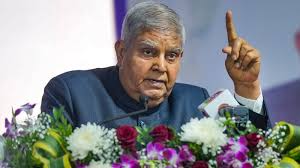Viksit Bharat not defined by Indian economy’s ranking; incomes have to increase 8 times: VP Jagdeep Dhankhar

India has made significant strides toward becoming a “Viksit Bharat” or Developed India. However, Vice President Jagdeep Dhankhar recently emphasized that true progress does not depend only on India’s place in global economic rankings or GDP numbers. Instead, he urged the country to focus on increasing the income levels of its citizens—calling for an eightfold rise in average incomes to achieve genuine development.
What Does Viksit Bharat Really Mean?
Vice President Dhankhar reminded everyone that development is more than just numbers on a chart. While GDP growth and rankings matter, they do not show how well the common people are doing. “When incomes rise substantially, people experience real improvements in their lives,” Dhankhar explained. He added that India will become truly developed only when the income of its citizens multiplies several times.
Viksit Bharat means inclusive growth where benefits reach every corner of the country. It means lifting up rural areas, marginalized groups, and all social classes. The Vice President stressed that raising incomes must become a top priority.
Income Inequality: A Challenge for India
India’s economy has grown quickly over the past few decades. The country ranks among the fastest-growing economies worldwide. Urban landscapes have transformed, and digital connectivity has spread widely. Yet, many people still face low wages, job insecurity, and limited access to basic services.
Vice President Dhankhar highlighted this issue, stating that without large income gains, growth benefits only a few. “It’s not enough for India to climb economic rankings,” he said. “Every Indian must feel the impact of that growth in their daily life.”
Why Focus on an Eightfold Increase?
The eightfold target for income growth is ambitious but necessary. Many households still earn barely enough to survive. If incomes rise eight times, families can afford better housing, healthcare, education, and nutrition. Higher incomes also strengthen domestic demand, creating a cycle of economic growth and job creation.
Such an increase would help millions move out of poverty and build a thriving middle class. This change would boost financial security and expand opportunities across the country.
How Can India Achieve This Goal?
Vice President Dhankhar pointed to several key areas that need focus to boost incomes drastically:
- Education and Skill Development: Training people with relevant skills prepares them for higher-paying jobs. Vocational programs, digital literacy, and lifelong learning can close the gap between education and employment.
- Promoting Entrepreneurship: Supporting startups and small businesses creates more jobs. Providing easier credit, mentorship, and fewer regulations will help more Indians become entrepreneurs.
- Agricultural Improvements: Since many rely on farming, boosting productivity and access to markets will raise rural incomes. Diversifying income sources will reduce dependence on uncertain crop yields.
- Infrastructure and Technology: Building roads, power supplies, and internet access in rural areas unlocks new economic opportunities. Technology can help people connect to markets and services.
- Social Security: Strengthening health insurance, pension schemes, and welfare programs protects vulnerable groups during economic changes.
- Inclusive Policies: Targeting support to marginalized groups and women ensures no one is left behind.
Technology and Innovation as Growth Drivers
Dhankhar stressed the role of innovation in increasing incomes. He encouraged investments in research and technology to create high-value jobs. India’s digital revolution has already transformed finance, education, and healthcare. Expanding these technologies can open new income streams and improve skills nationwide.
Economic Rankings vs. Real Prosperity
While India’s rise as a major economy is impressive, the Vice President urged the nation to look beyond rankings. “Being a developed country means ensuring every citizen enjoys a dignified life with financial security,” he said.
This idea aligns with global development goals focused on human well-being and equality—not just aggregate economic figures.
Conclusion: Putting People First in the Path to Viksit Bharat
Vice President Jagdeep Dhankhar’s message calls for a shift in India’s development approach. It moves the focus from statistics to real-life improvements. The goal is clear: incomes must grow significantly for millions of Indians to enjoy better lives.
India’s journey toward Viksit Bharat depends on inclusive growth that uplifts all communities. The country can achieve this through education, entrepreneurship, technology, and social safety nets.
Only when millions experience meaningful income growth can India truly claim to be a developed nation. Dhankhar’s vision reminds us that development must be measured by people’s prosperity—not just economic rankings.






